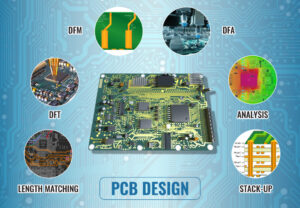1. The spacing size between SMD components: Too small spacing will increase the difficulty of solder paste and generate solder current between solder pads.
2. The spacing size between surface mount components and plug-in components: There should be sufficient spacing between DIP and SMT components, with a recommended spacing of 1-3mm.
3. Placement of IC decoupling capacitors: Place decoupling capacitors as close as possible to the integrated circuit (IC) on the PCB layout. When an IC has multiple power supply ports, each power supply port needs to be matched with a decoupling capacitor.
4. Direction and spacing of components near the boundary: Components near the PCB boundary must be parallel to the board outline and placed in the area near the PCB board
5. Serpentine routing design: For example, some serial SMD pads need to be connected to each other through snake routing design, rather than direct bridging, and attention should be paid to width.
6. Pay attention to the heat dissipation of specific area pads: the better the heat dissipation, the better the performance of the components. Therefore, PCB design engineers need to pay attention to how to design and layout PCBs to prevent heat accumulation in certain areas.
7. PCB tears in layout: Tears are extra copper with certain specific shapes used in PCB layout to provide additional strength, making the through holes strong enough to withstand thermal and mechanical stresses.
8. The wiring width between solder pads should be consistent: each wiring connected to the solder pad should have the same width dimension
9. There is sufficient spacing between the wiring or components and the PCB board: keep the spacing between the wiring or components and the PCB board as large as possible.
10. Electrolytic capacitors should be kept away from possible heat sources as much as possible: firstly, it is necessary to verify whether the electrolytic capacitor matches the operating temperature of the electronic device. Secondly, the electrolytic capacitor should be kept away from heat sources as much as possible to avoid the internal electrolyte drying up due to the impact of heat sources.
















